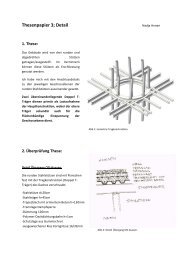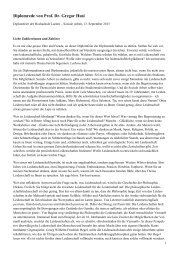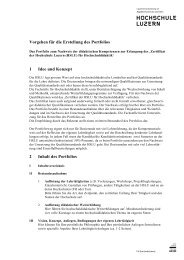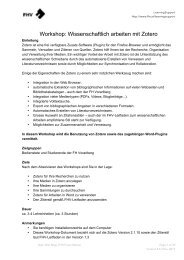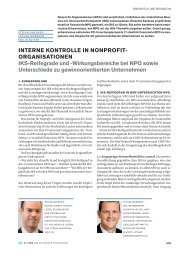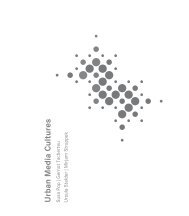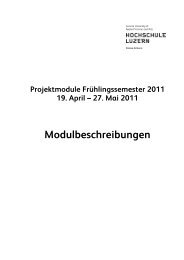Designwissenschaft und Designforschung: Ein einführender Überblick
Designwissenschaft und Designforschung: Ein einführender Überblick
Designwissenschaft und Designforschung: Ein einführender Überblick
Sie wollen auch ein ePaper? Erhöhen Sie die Reichweite Ihrer Titel.
YUMPU macht aus Druck-PDFs automatisch weboptimierte ePaper, die Google liebt.
Issues � <strong>Designforschung</strong> � Felder von <strong>Designforschung</strong><br />
Ad 6:<br />
Blinde Flecken von <strong>Designforschung</strong>:<br />
Kees Dorst (2008)<br />
Kees Dorst ist Professor an der University of Technology<br />
Sydney. <strong>Ein</strong>en <strong>Ein</strong>druck über den Zweck von Systematisierungsversuchen<br />
kann man bei Dorst gewinnen, der von<br />
einer <strong>Ein</strong>schätzung des State of the Art in <strong>Designforschung</strong><br />
ausgeht <strong>und</strong> danach fragt, ob man auf dem eingeschlagenen<br />
Weg weitergehen könne bzw. sollte, oder ob man nicht eher<br />
die bestehenden Annahmen <strong>und</strong> Arbeitsweisen überdenken<br />
sollte. Dorst geht das Thema Systematisierung zuerst theoretisch<br />
an, wenn er sagt:<br />
«Let us start with a thought experiment. If one would<br />
start a new scientific discipline that is aimed at the study<br />
of a complex area of human activity like design, how<br />
would one go about it? One would probably first observe<br />
this complex activity, and then describe it (which<br />
already involves a degree of interpretation). Then one<br />
would seek to create models that could explain the<br />
phenomena as observed and described. That explanatory<br />
framework could then be used to prescribe ways in<br />
which practice could be improved, developing methods<br />
and tools to support the practitioner and the student.<br />
There is a certain logic to this progression, yet historians<br />
have shown us that in our own field of design<br />
research, this is not what happened at all. […]<br />
If we continue our thought experiment now, let us<br />
zoom in on what you would need to do if you want to<br />
describe an area of complex creative human endeavour<br />
like design. What would be the elements of such a descriptive<br />
framework? Well, one would need to describe<br />
the object of this activity (in this case, the design problem<br />
and the emerging design solution – the ‹content›),<br />
the actor (the designer or the design team/designing<br />
organisation), the context in which the activity takes<br />
place (as far as it impacts upon the activity) and the<br />
structure and dynamics of the complex of activities that<br />
is being studied (‹the design process›).<br />
Yet when we look at the design methods and tools<br />
that are being developed within the design research<br />
community, we see that three of these four ‹aspects of<br />
38<br />
design activity› are often ignored within the descriptive<br />
framework that implicitly <strong>und</strong>erlies our thinking<br />
on design. The overwhelming majority of descriptive<br />
and prescriptive work in design research focuses on<br />
the design process, to the exclusion of everything else.<br />
Therefore the design methods and tools that are being<br />
developed inevitably focus on enhancing the efficiency<br />
and effectiveness of design processes. And apparently,<br />
this total ignoring of the design content, the designer<br />
and the design context allows us to claim that we are<br />
constructing models, methods and tools that will be valid<br />
for every designer, dealing with every possible kind<br />
of design problem, in any situation.»<br />
(Dorst, 2008, pp. 4-5)<br />
Dorst führt diese Tatsache auf den blinden Fleck von<br />
<strong>Designforschung</strong> zurück, der Issues ausblendet, die mit dem<br />
Designer selbst, dem Inhalt von Designaktivitäten <strong>und</strong> dem<br />
Kontext, in welchem diese Aktivitäten stattfinden,<br />
zu tun haben.<br />
«Yet, as we have seen, design research has a blind spot<br />
for issues to do with the designer, the content of the<br />
design activity and the context in which that activity<br />
takes place. So these momentous changes do not show<br />
up on our radar.»<br />
(Dorst, 2008, p. 7)<br />
Dorst kritisiert das Fehlen von erklärenden Frameworks,<br />
was es schwierig mache, eine akademische Wissensbasis<br />
aufzubauen. Bestehende Frameworks seien vorwiegend<br />
deskriptiv oder präskriptiv, selten jedenfalls erklärend.<br />
Methoden würden kaum auf Designsituationen bezogen<br />
<strong>und</strong> Designaktivitäten ausserhalb des Kontexts von<br />
Designprojekten seien kaum in Forschungserwägungen<br />
einbezogen.<br />
«As it is, the lack of an explanatory framework for<br />
design makes it hard to build up an academic knowledge<br />
base, and it makes it well-nigh impossible to<br />
reflect critically upon each other’s work. This gives rise<br />
to a suspicion of shallowness and leaves us with a<br />
pretty bleak picture of design research as a field of<br />
intellectual, academic inquiry.



